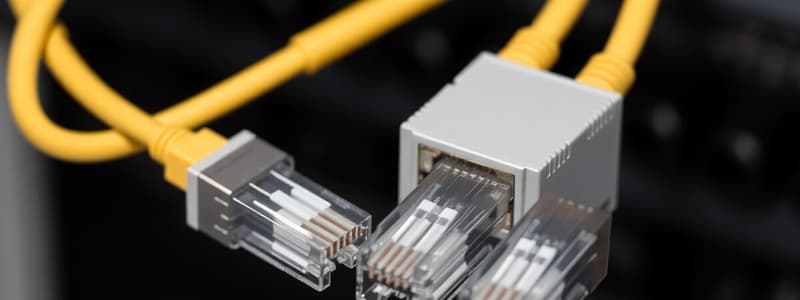Podcast
Questions and Answers
Which of the following is a common characteristic of a networking medium?
Which of the following is a common characteristic of a networking medium?
- Wireless compatibility
- Interference susceptibility (correct)
- Signal strength
- Data compression rate
Which type of fiber-optic connector provides high density and requires only one connector for two cables?
Which type of fiber-optic connector provides high density and requires only one connector for two cables?
- ST
- RJ-45
- MT-RJ (correct)
- SC
What is the primary reason for limiting the maximum length of network cables?
What is the primary reason for limiting the maximum length of network cables?
- Diminution (correct)
- Material strength
- Cost efficiency
- Interference reduction
Which process is used for representing bit signals on a networking medium?
Which process is used for representing bit signals on a networking medium?
What generally happens to signals as they travel the length of the medium?
What generally happens to signals as they travel the length of the medium?
Which of the following factors is UTP susceptible to?
Which of the following factors is UTP susceptible to?
What type of cable is most resistant to electronic eavesdropping?
What type of cable is most resistant to electronic eavesdropping?
Which characteristic is associated with fiber-optic cabling?
Which characteristic is associated with fiber-optic cabling?
What phenomenon occurs when signals traveling down one wire interfere with those on another wire?
What phenomenon occurs when signals traveling down one wire interfere with those on another wire?
Which cable category is specified for 25GBaseT and 40GBaseT networks?
Which cable category is specified for 25GBaseT and 40GBaseT networks?
Which wiring standard is associated with twisted-pair cable connections?
Which wiring standard is associated with twisted-pair cable connections?
Which component is typically found in a structured cabling system?
Which component is typically found in a structured cabling system?
Where are you most likely to find backbone cabling?
Where are you most likely to find backbone cabling?
Which tool is necessary for making a patch cable?
Which tool is necessary for making a patch cable?
Which limitations of UTP can be resolved by using fiber-optic cables?
Which limitations of UTP can be resolved by using fiber-optic cables?
How many strands of fiber-optic cable are typically used for a network connection?
How many strands of fiber-optic cable are typically used for a network connection?
Flashcards are hidden until you start studying
Study Notes
Networking Medium Characteristics
- Common characteristics include bandwidth rating, interference susceptibility, and maximum segment length.
- No common characteristic of a networking medium falls under broadband rating.
Fiber-Optic Connectors
- MT-RJ connector is high density, requiring one connector for two cables.
- SC and ST connectors do not have this feature; RJ-45 is not a fiber-optic connector.
Cable Length Conditions
- Cables must not exceed maximum length due to attenuation, which refers to signal loss over distance.
Bit Signal Representation
- Encoding is the process for representing bit signals on transmission mediums.
Signal Behavior in Transmission
- Signals attenuate as they travel along the medium, indicating a reduction in strength.
UTP Susceptibility
- Unshielded Twisted Pair (UTP) cables are susceptible to electromagnetic interference (EMI) and crosstalk.
Ceiling Airspace
- The space between a false ceiling and the true ceiling where air circulates is called a plenum.
Common TP Network Connector
- RJ-45 is the most commonly used connector for twisted-pair (TP) network wiring.
Eavesdropping Resistant Cables
- Fiber optic cables are most resistant to electronic eavesdropping.
Characteristics of UTP
- Unshielded twisted-pair cable typically consists of four wires and has a distance limitation of 100 meters. It is also prone to electrical interference but can be used in physical bus topologies.
Characteristics of Fiber-Optic Cabling
- Fiber-optic cables can operate in electrically noisy environments, can carry data over longer distances than UTP, and generally feature high bandwidth.
Future-Proof Ethernet Cables
- For potential switchover to 1 Gbps Ethernet, consider installing Cat 5, Cat 6, or fiber optic cables.
Crosstalk Phenomenon
- When two cables run side by side, the interference is known as crosstalk.
Mitigation of Crosstalk
- Twisted-pair cabling mitigates crosstalk through the use of differential signals.
Cabling Category for High-Speed Networks
- Cat 6a and Cat 8 are specified for 25GBaseT and 40GBaseT networks.
Wiring Standards for Twisted-Pair Cable
- Relevant wiring standards include TIA/EIA 568A and TIA/EIA 568B.
Components of Structured Cabling
- Key components include patch cables and horizontal wiring; RJ-11 plugs and coax cable are not standard for structured cabling.
Backbone Cabling Locations
- Backbone cabling is typically found in MDF rooms, between IDFs, or connecting work areas to an IDF.
Tools for Patch Cable Making
- Essential tools for making patch cables include cable strippers, crimping tools, and RJ-45 jacks; 110 punchdown tools are not required.
Crossover Cable Connections
- Crossover cables are most likely needed for PC to router connections.
Fiber-Optic Solutions to UTP Limitations
- Fiber-optic cables address UTP limitations related to bandwidth, EMI susceptibility, and segment length.
Fiber-Optic Strands
- Typical fiber-optic network connections use 2 strands.
Fiber-Optic Cabling Facts
- Multimode Fiber (MMF) uses LEDs and has a thicker core; Singlemode Fiber (SMF) employs lasers and has a thinner core.
Rollover Cable Use
- Rollover cables are used to configure Cisco devices and connect a PC to that device.
802.11b Wireless Technology
- Original 802.11b standard utilizes specific wireless technologies to transmit data.
Studying That Suits You
Use AI to generate personalized quizzes and flashcards to suit your learning preferences.




